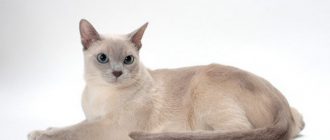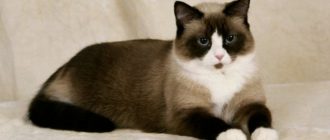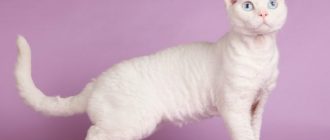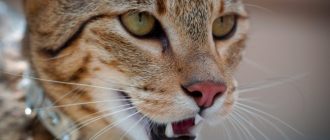Brief description of the breed
Contents
Scottish fold cats (otherwise their breed sounds like scottish fold) – medium sized pets, weight ranges from 3-6 kg, the height at the withers is about 30 cm. A distinctive feature of these animals – small ears, directed forward, with some tips down, huge attentive eyes, streamlined body shapes and a peculiar creaky voice. Bred in the 60s of XX century, Scottish fold can have both short velvety and silky coat half-length. Interestingly, in cats Scottish fold can kittens are born with both ears down and with ordinary ones. Those cats whose ears did not accept the characteristic Scottish folds oblique, called Scottish straight (or Scottish Straight). The homeland of Scottish Folds is Scotland, about which, Of course, it is clear from the name of the breed. In appearance, Scottish lop-eared impress moderately muscular cats, with smooth, like rounded lines of the body. The head is round in shape, with well-developed chin, vibrissa pads and jaws. The eyes are round and large, widely spaced. (blue, yellow, green, light brown, white heterochromia often occurs in animals). The nose is short and wide. The ears are small, rounded at the tips, directed forward and down. The neck is short, passing smoothly into a strong dense body. Breast the cell is well developed, moderately wide. Extremities of medium length, s rounded neat paws. The tail is long, tapering to the tip. Wool, as mentioned above, can be thick, short with good undercoat, and half-length (the longest cover on the neck, tail and hind limbs). Scottish colors fold – white, black, brown, cream, red, blue, smoky, spotted, tabby, marble (various shades), harlequin (white body with marks of a different color, occupying no more than 1/5 color), van (white body with a few small marks a different shade), bi-color (a combination of white with a different color), tortie (black body interspersed with red and white).
Photo of a Scottish fold cat:
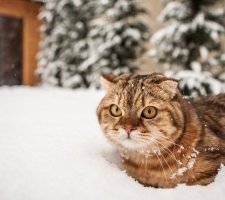
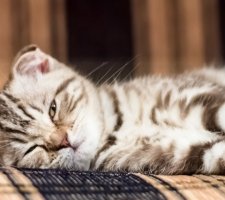

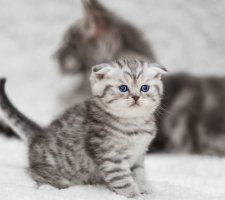

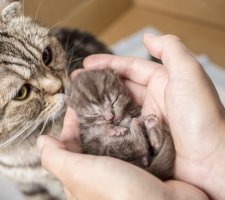
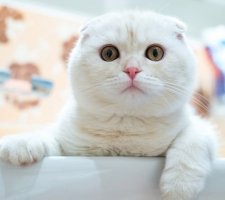


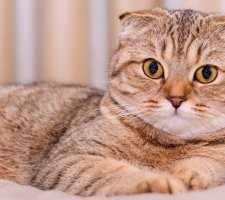

 Pictures of Dog Breeds |
Pictures of Dog Breeds |
The story of a Scottish fold cat
Interest in the breed was shown by an ordinary married couple – Scottish shepherd William Ross and his wife named Mary in 1959 year. At a neighboring farm, Ross spotted a white cat, ears which had an unusual shape. Inquiring from the owner of Suzy (that was the name of the cat) about its origin, William Ross found out that his mother she was a cat of British breed, and her father is unknown. In the litter two kittens with hanging ears were born at once – Suzy herself and her brother, which in due time disappeared without a trace. Ross and his wife are so I liked the fold cat of the neighbors, which after 2 years, in In 1961, they gratefully accepted the gift of a baby kitten, whom gave birth to Susie from a local cat. The kitten girl got the name Snooks, her ears were exactly like Susie’s. And interest in Ross’s lop-eared individuals, even after acquiring a kitten, do not gone, on the contrary, Mary decided to breed these unusual cats. Over time, Snux was crossed with an ordinary purebred cat, who lived on the Ross farm – in this litter, among others, was born two kittens with hanging ears. It can be said that it is from this moment and the story of Scottish fold – descendants began British Shorthair and other cats, the breed of which not known for certain. Breeders who are interested Ross cats, it was revealed that unusual ears are the result of gene mutations. Since 1963, work began on the breeding of the breed scottish fold, and the first animals to become official the ancestors were Scottish Fold Snowball (son of Snooks) and british female. Also to Scottish fold (besides British Shorthair) were surged over time with exotic blood, Persian, American Shorthair cats. However, almost through 10 years after the start of breeding cats Scottish fold the English organization of felinologists suspended them breeding breeding. The difficulty was that when crossing Scottish cats with hanging ears were born kittens with significant problems of the musculoskeletal system. Already in 1971 Scottish Folds moved to the United States, where geneticists were decided to work on breeding and improving the breed. The main idea of the specialists was the crossing of lop-eared individuals with straight Scottish and British cats, during which Scottish folds and Scottish Straights without innate appeared bone abnormalities. And already in 1973, the breed began to register in American felinological associations gaining popularity on US territory. Scottish folds with long hair were recognized only in 1980.
Scottish fold cat character
Scottish fold cats are amazing animals by nature. We can say that the nature of these cats is the golden mean among the entire cat family. They are good-natured, fast become attached to the owner, but are never too annoying, requiring a lot of attention to their person. Lop-eared cats well contact with children, love to play. But most often choose the favorites of one of the family members (usually the owner). They can get along even in a small area with other animals, not entering into conflicts. In adulthood, they can not be called overly active because Scottish folds like to nap, relaxing on the owner’s lap or in some comfortable place. Whereas in childhood, Scottish toddlers try to explore all corners in the House. Their indisputable advantages are cleanliness and accuracy. Rarely Scottish fold cross the line of what is permitted – do puddles outside the tray or claws on furniture. Accustomed from childhood to order, they exist beautifully even in a small apartment, not causing inconvenience to the owner. They rarely give voice, they only do it when necessary, when hungry, for example. This is enough calm, kind and loyal cats that can get along practically in any family. Despite their soft and balanced disposition, scottish folds are not shy and overly shy cats, which greatly facilitates their transportation. To these animals don’t need any special approach – only good attitude and affection, as well as simple care.
Maintenance and care
Unpretentious in care, Scottish fold are quite burdensome pets. Especially it concerns short-haired breed – it is enough to comb them weekly with a brush. Longhair Scottish folds will require large efforts – they will have to be looked after every day to avoid tangles of hair. For ease of care, you can purchase a furminator – a device for removing dead hair and giving external type of pet well-groomed. Combing long-haired cats – necessary procedure, allowing not only to warn the appearance of tangles, but also the formation of wool lumps in the stomach (which are formed in the process of licking). For longhair Scots as a preventive measure it is advisable to purchase pastes for removing wool from the body. They bathe cats of this breed no more often 1 every 2 months (or monthly if necessary) with shampoos designed for long or short hair (in depending on the type of Scottish fold). Cat eyes wiped with a swab. (or cloth) moistened with clean water. Pressed ears are not require special care – they are cleaned with cotton buds, removing excess sulfur once a week. Teeth are brushed every day (or at least several times a week) using a special paste (usually with meat flavors – chicken, beef, etc.) and brushes. True sharp the need for brushing is primarily for animals, who are on natural feeding. Ready dry feeds cleanse plaque while eating. But still the cat’s mouth should be periodically examined by the owner for inflamed gum, tartar, or bad smell. All of these procedures (a also combing and washing) should be carried out with a kitten from the first months of his life. Then the animal will not have a reason for stress, but the owner will be able to take care quickly and efficiently. For leisure Cats will need toys and a scratching post, as well as owner time. Although the Scottish fold can entertain themselves yourself, the owner should not neglect communication and games with the cat. For rest and sleep you will need a medium-sized open bed or closed type. Close to a couch (or other accessible for an animal place) should also place a tray with a filler, for whose purity must be constantly monitored – cats by nature clean, so an unpleasant pungent smell of urine and feces can lead to the search for a new latrine, for example, under the bed or another nook.
Feeding
A kitten aged 2-4 months should be fed about 5-6 times per day, from 4 to 6 months the number of feeds is reduced to 4, from 6 up to 8 months, the pet needs 3-4 meals a day, and already with 8 months of age, there is a transition to 2 meals a day. It is preferable to feed a cat in the morning and in the evening. And be sure to monitor the continued availability of clean drinking water in a bowl (It is advisable to change the water at least 1 time per day). Type of food Scottish fold can be natural, industrial and combined. Each of these rations has advantages and disadvantages.
- Natural nutrition – food prepared by the owner specially for the cat. The main bias in the natural diet is done low-fat meat (chicken, rabbit, veal), which can be given to the animal in boiled or raw (after a deep 5-7 day frost) form. Before serving, grind the meat and slightly warm up (a little warmer than room temperature). Daily present in the diet, the meat should be alternately mixed with vegetables (raw or boiled cabbage, zucchini, pumpkin, carrots), bran and cereals (oat, rice and buckwheat). You can replace meat with offal – liver, heart, stomachs, also boiled and chopped, mixed subsequently with vegetables, porridge or bran. Cat dishes can be seasoned a small amount of sunflower, olive or linseed oil. Also, greens (parsley, lettuce leaves), which in chopped form can be added to dishes. Cat fish can only be sea, boiled and spared. Unlike from meat, the fish is given to the cat no more than 2-3 times a week. Sour-milk products can be given to the cat daily or every other day, giving preferences for low-fat cottage cheese, yogurt, fermented baked milk and kefir (from sour cream, cream and milk is better to refuse). Even to save time should not feed the cat food from the table – fried, oily, spicy. Moreover, it’s not worth the fun to treat the cat with alcohol, chocolate and other beverages and products not intended for animals. For cats with a natural diet annually (usually in the fall and in spring) vitamin complexes are prescribed to fill the deficit minerals, vitamins and amino acids. Preferably before purchase vitamins consult your veterinarian.
- Ready-made diet – dry granular or wet food. This type of food saves the owner’s time as it requires just open the jar or box with the product immediately before feeding. However, before buying ready-made feed, you should read its composition. The owner of the cat should be alert as part of the absence (or a negligible amount) of meat, a large content of animals and vegetable fats, cereals (especially corn). These are the main ingredients of the most harmful and cheap feeds that adversely affect the whole body of a cat. Therefore, it is better to buy ready-made cat food quality not lower than the premium level (and preferably extra-premium), and then reading the composition before purchasing and consulting with by the veterinarian.
- The combined type of food is the alternation of the finished feed with natural. For example, in the morning the animal receives canned purchased product, and in the evening the owner gives the cat do-it-yourself something (meat, fish or offal with vegetables or other). However, some owners have a negative attitude towards combining food, considering that mixing is harmful digestion of the animal.
Products for cats should be fresh, served in a clean bowl. You should not overfeed the animal, even with good intentions – this can lead to obesity, diseases of the cardiovascular and endocrine systems, disorders of the musculoskeletal system apparatus. When choosing a ready-made food for a Scottish fold cat you should purchase the product in accordance with the age of the animal.
Health and Disease
Scottish folds live for about 12-15 years, almost until maintaining good health (provided good care and good nutrition). Infrequent, but very serious diseases Scottish fold – osteochondrodystrophy (congenital progressive bone deformity) and hemophilia (genetic bleeding disorder). However acquiring a kitten in a reputable nursery gives hope that the pet from healthy parents will grow strong, not suffering any in adversity. Wherever a cat is purchased, the owner must be sure to take care of her vaccination (from panleukopenia, rabies, calcivirosis, herpes virus infection). Kittens from nurseries, as a rule, already have marks in documents on received vaccination. Mandatory before vaccination elimination procedures and prevention of fleas, ticks, helminths.

